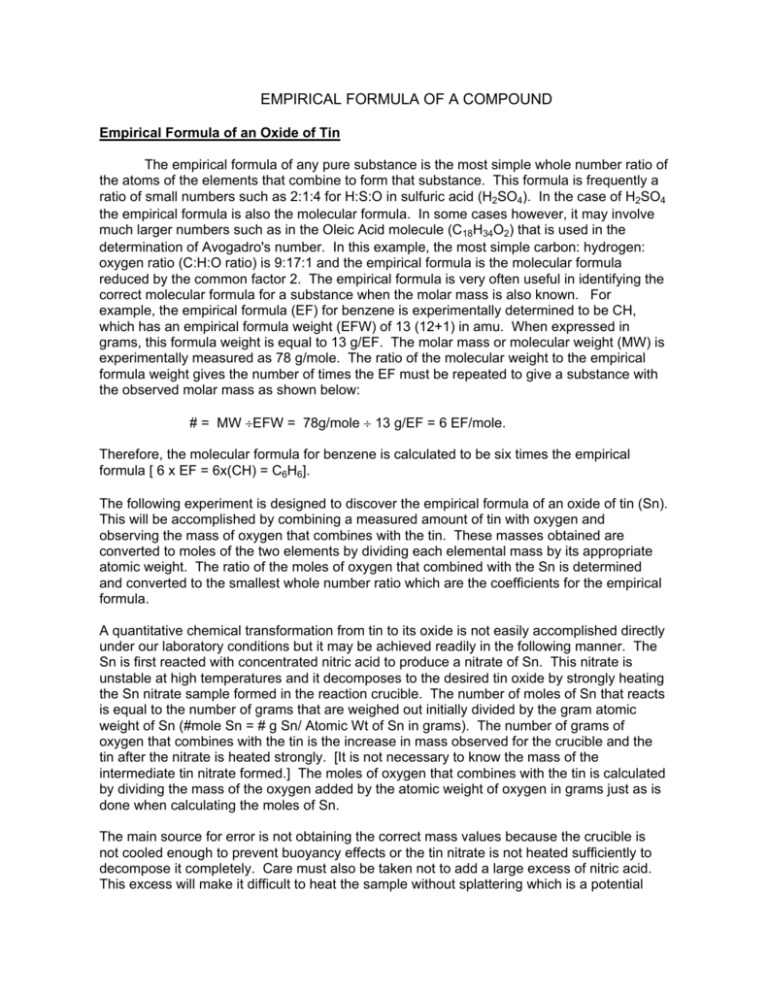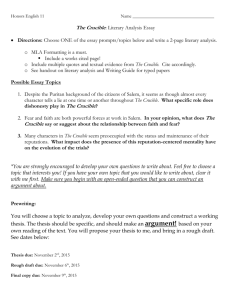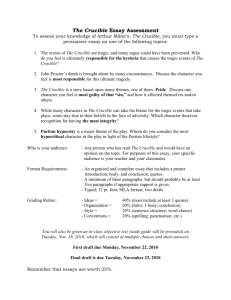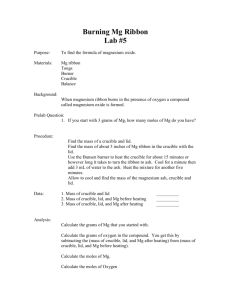The Empirical Formula of a Compound
advertisement

EMPIRICAL FORMULA OF A COMPOUND Empirical Formula of an Oxide of Tin The empirical formula of any pure substance is the most simple whole number ratio of the atoms of the elements that combine to form that substance. This formula is frequently a ratio of small numbers such as 2:1:4 for H:S:O in sulfuric acid (H2SO4). In the case of H2SO4 the empirical formula is also the molecular formula. In some cases however, it may involve much larger numbers such as in the Oleic Acid molecule (C18H34O2) that is used in the determination of Avogadro's number. In this example, the most simple carbon: hydrogen: oxygen ratio (C:H:O ratio) is 9:17:1 and the empirical formula is the molecular formula reduced by the common factor 2. The empirical formula is very often useful in identifying the correct molecular formula for a substance when the molar mass is also known. For example, the empirical formula (EF) for benzene is experimentally determined to be CH, which has an empirical formula weight (EFW) of 13 (12+1) in amu. When expressed in grams, this formula weight is equal to 13 g/EF. The molar mass or molecular weight (MW) is experimentally measured as 78 g/mole. The ratio of the molecular weight to the empirical formula weight gives the number of times the EF must be repeated to give a substance with the observed molar mass as shown below: # = MW ÷EFW = 78g/mole ÷ 13 g/EF = 6 EF/mole. Therefore, the molecular formula for benzene is calculated to be six times the empirical formula [ 6 x EF = 6x(CH) = C6H6]. The following experiment is designed to discover the empirical formula of an oxide of tin (Sn). This will be accomplished by combining a measured amount of tin with oxygen and observing the mass of oxygen that combines with the tin. These masses obtained are converted to moles of the two elements by dividing each elemental mass by its appropriate atomic weight. The ratio of the moles of oxygen that combined with the Sn is determined and converted to the smallest whole number ratio which are the coefficients for the empirical formula. A quantitative chemical transformation from tin to its oxide is not easily accomplished directly under our laboratory conditions but it may be achieved readily in the following manner. The Sn is first reacted with concentrated nitric acid to produce a nitrate of Sn. This nitrate is unstable at high temperatures and it decomposes to the desired tin oxide by strongly heating the Sn nitrate sample formed in the reaction crucible. The number of moles of Sn that reacts is equal to the number of grams that are weighed out initially divided by the gram atomic weight of Sn (#mole Sn = # g Sn/ Atomic Wt of Sn in grams). The number of grams of oxygen that combines with the tin is the increase in mass observed for the crucible and the tin after the nitrate is heated strongly. [It is not necessary to know the mass of the intermediate tin nitrate formed.] The moles of oxygen that combines with the tin is calculated by dividing the mass of the oxygen added by the atomic weight of oxygen in grams just as is done when calculating the moles of Sn. The main source for error is not obtaining the correct mass values because the crucible is not cooled enough to prevent buoyancy effects or the tin nitrate is not heated sufficiently to decompose it completely. Care must also be taken not to add a large excess of nitric acid. This excess will make it difficult to heat the sample without splattering which is a potential source of critical error in the experiment that will lead to inaccurate results. After the addition of the nitric acid, the material in the crucible should appear similar to yellow cottage cheese. PROCEDURE Obtain two porcelain crucibles and lids. Inspect them closely for cracks and discard any crucibles that are cracked. If you obtain a dirty crucible, scrape out any loose material with your spatula. Clean the crucibles well with soap and water; then dry them inside and out with a paper towel. Place one of the crucibles on a clay triangle that is resting on an iron ring supported by a ring stand. Cover the crucible with the lid set slightly ajar so that air and moisture may escape during the heating process. Heat the crucible directly over a Bunsen burner with a very hot flame until the bottom glows red-orange for three to five minutes. Remove the crucible and lid from the flame with your crucible tongs. [Always hold the tongs with the tips pointed upward to handle both the crucible and the lid.] Place the hot crucible and lid directly onto a wire gauze on the laboratory bench top. [DO NOT place the hot crucible and lid directly onto the lab bench top as this may cause the crucible to crack. This could happen without your noticing it, and the crucible might fall apart later in the experiment with disastrous results.] Allow the crucible to cool for 8-10 minutes or until it no longer feels warm to the back of your hand. While the first crucible is cooling, repeat this heating procedure with the second crucible and lid. While the second crucible is heating, weigh the first crucible and lid after it has cooled sufficiently. Record this mass on the data page to the nearest 0.001 g. Remove the second crucible and lid form the flame and allow it to cool. While the second crucible and lid are cooling, reheat the first crucible and lid as you did initially. During this time, weigh the second crucible and lid when it has cooled and record this mass as you did for the first one. Be sure to keep track of which lid goes with each crucible because the lids do not all weigh the same. DO NOT HANDLE THE CRUCIBLES AND LIDS WITH YOUR FINGERS. ONLY USE THE CRUCIBLE TONGS TO HANDLE THESE ITEMS ONCE THE HEATING PROCESS HAS BEGUN. Continue this heating and weighing process until two successive weights for each crucible agree to within ± 0.003 g. You can now assume that all of the impurities that may have been in the crucible have been burned out. Remember, the crucible and lid combinations will not have identical masses, but re-weighings of the same crucible and lid should give agreement to within ± 0.003g for successive weighings before you proceed with the addition of the Sn. Once the crucibles and lids are to constant weight add just slightly more than a gram of granular Sn to each crucible by pouring the metal from the bottle while rolling the bottle slightly to cause the metal to move toward the opening of the bottle. Although no specific quantity of Sn is designated, the amount of Sn should be between 1.000 g and 1.200 g and the amounts used should be recorded to the nearest 0.001g. Place the first crucible on the clay triangle again and move the stand as near the fume hood as possible. To each crucible, add concentrated nitric acid, HNO3, in the following manner: 1. Add 6 drops at first to initiate the reaction. If the reaction does not start within about ten seconds, add 2-3 drops of distilled water from the wash bottle. 2. After the reaction begins, allow the initial reaction rate to decrease until very little or no brown vapors are forming. Then add HNO3 6 drops at a time and wait until the reaction subsides once again. Repeat this as needed until there is a slight excess of unreacted acid. This will occur when the addition of the acid no longer causes brown fumes to be released from the sample and the sample has the appearance of slightly yellowed cottage cheese. AVOID BREATHING THE BROWN FUMES AS THEY CAN CAUSE PULMONARY EDEMA. At this point the crucibles should be warmed gently with the lid slightly ajar to evaporate excess liquid. Be very careful not to heat too strongly during the initial heating as the contents of the crucible may start to spatter and some of the contents will be lost. Any loss of material will seriously affect the results of the experiment. The lid must be placed over the crucible in such a manner that there is a small opening to permit moisture and other gasses to escape, but not let any of the solid products spatter out of the crucible. When you no longer hear a frying or crackling sound from the crucible the moisture has evaporated and spattering should no longer be a concern. As soon as you are certain all of the liquid has evaporated, heat the crucible, lid and contents with a hot flame as you did in the beginning of the procedure with the empty crucible. However, start the strong heating slowly, listening for any sounds that would indicate the sample is still moist. If there is any reason to believe there is still water present reduce the heat and continue heating cautiously. Heat the crucible, lid and contents with the bottom glowing red-orange for at least five minutes or until there are no more brown fumes escaping. Remove the first crucible from the flame and allow it to cool while the second crucible is heated as the first. When the first crucible has cooled, reweigh it with its lid and record this mass as you did before when it was empty. Add three drops of concentrated HNO3 to the crucible and note if there is any evidence of further reaction by the tin such as brown vapors being released. If this happens, keep adding HNO3 as was done earlier until no more reaction occurs. While the second crucible is cooling, reheat the first crucible until the bottom glows for five minutes. Continue this cyclic process of adding HNO3 , heating and cooling until two successive weightings for each crucible agree to within ± 0.003 grams. When the crucible is at constant weight record the last value measured. When you are certain you are finished with a sample, you may discard the product as instructed, clean and wash the crucibles and return them to the container from which they were obtained. The tin has been converted to one of the possible tin oxide compounds. From the data obtained in this experiment, calculate the empirical formula of the tin oxide produced. DATA Mass of empty crucible and lid crucible #1 crucible #2 crucible#3 crucible #4 After First Heating _________ _________ _________ _________ Second Heating _________ _________ _________ _________ Third Heating _________ _________ _________ _________ Fourth Heating _________ _________ _________ _________ Fifth Heating _________ _________ _________ ________ Mass of Crucible, lid and Sn _________ _________ _________ _________ Mass of crucible, lid and tin oxide After First Heating _________ _________ _________ _________ Second Heating _________ _________ _________ _________ Third Heating _________ _________ _________ _________ Fourth Heating _________ _________ _________ _________ Fifth Heating _________ _________ _________ ________ CALCULATIONS The following calculations are to be done with the data for one crucible prior to leaving the ® laboratory. The complete calculations should be done with Excel . Enter the data table information into the spreadsheet. Set up the calculation with the data for the first crucible and then copy the equations for the second crucible to the right of the same calculation for crucible # 1. Be sure to submit a copy of your formula sheet to illustrate how the calculations were done. 1. Calculate the mass of Sn used. 2. Calculate the mass of oxygen that reacts with the Sn. 3. Calculate the moles of Sn used. Report the answer to three significant figures. 4. Calculate the number of moles of atomic oxygen that reacted with the tin. Report the answer to three significant figures. 5. From the results of the calculations in parts 3 and 4 determine the ratio of moles of oxygen to the moles of Sn. Report the results to three significant figures. Convert these numbers to integer values by either rounding or by multiplying both coefficients by an integer number that will make both values approximately whole numbers. Round these last values to the nearest whole number and write the empirical formula for the tin oxide. Name _______________________ Instructor's Copy: DATA Mass of empty crucible and lid crucible #1 crucible #2 crucible#3 crucible #4 After First Heating _________ _________ _________ _________ Second Heating _________ _________ _________ _________ Third Heating _________ _________ _________ _________ Fourth Heating _________ _________ _________ _________ Fifth Heating _________ _________ _________ ________ Mass of Crucible, lid and Sn _________ _________ _________ _________ Mass of crucible, lid and tin oxide After First Heating _________ _________ _________ _________ Second Heating _________ _________ _________ _________ Third Heating _________ _________ _________ _________ Fourth Heating _________ _________ _________ _________ Fifth Heating _________ _________ _________ ________







